Lifestyle Medicine Curriculum: Transforming the Globe
By Danelle M. Taylor Johnston, MA
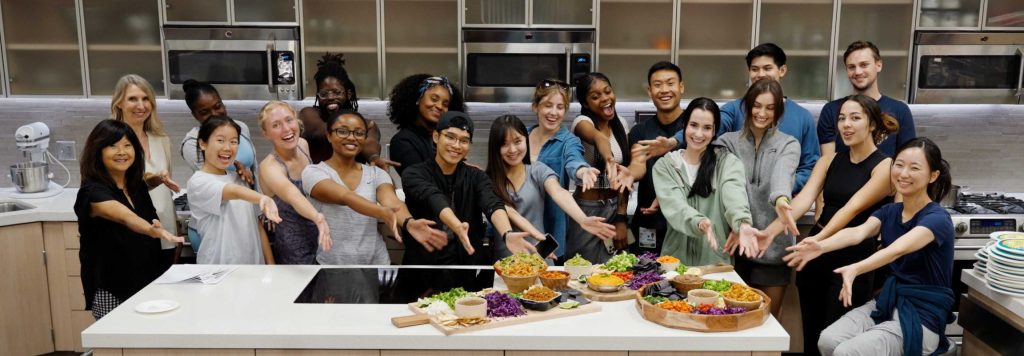
L
oma Linda University School of Medicine (LLUSM) leads the way nationally in lifestyle medicine, along with its colleagues at the University of South Carolina Greenville, the first two American medical schools to earn the American College of Lifestyle Medicine Platinum Plus Certification for their lifestyle curriculum. Read more here.
Lifestyle medicine is a whole-person approach to healing founded on six pillars: whole food plant-based nutrition, restorative sleep, positive social connections, regular physical activity, avoiding risky substances, and stress management. If large populations practiced these behaviors, there could be as much as a 70–90% reduction in risk for type 2 diabetes, heart disease, stroke, and some cancers.1, 2, 3
Lifestyle medicine was integral to the foundation of Loma Linda University, with its lifestyle roots extending back to the Loma Linda Sanitarium. People traveled far for its healing baths, exercise, community, and nutritious food. However, as medicine advanced, Loma Linda’s focus shifted from lifestyle approaches to current technology, procedures, and medications. With these cultural shifts in the practice of medicine, LLU began doing more research on the benefits of a healthy lifestyle through the Adventist Health Study,4 to demonstrate the value of these behaviors that were losing traction in the wider medical world but still highly valued within the Seventh-day Adventist community.
Then, 20 years ago, the American College of Lifestyle Medicine (ACLM) was formed by a group of medical professionals largely from LLU, who recognized that health care was quickly becoming unsustainable. Wayne Dysinger ’86, MPH, chair of the LLUSM department of preventive medicine from 2003 to 2014, was a founding ACLM member along with current faculty, Brenda L. Rea ’11, DrPH, program director of LLUSM’s Lifestyle Medicine Intensivist Fellowship; and Sylvia Cramer, LLUSPH’89, DrPH. Dysinger went on to become the president of ACLM from 2009–2012. “It’s remarkable that four of the first five presidents of ACLM are from Loma Linda University,” Dysinger said. The first president was John H. Kelly, Jr., ’00, MPH; followed by Marcus A. Braman ’95, MPH; Dysinger; and George E. Guthrie ’81, MPH.
At the same time that ACLM was forming, April Wilson ’06, MPH, chair of the LLUSM department of preventive medicine from 2017–2024, was in her third year of medical school. This “new” discipline of lifestyle medicine intrigued her and her friends. “We wanted to figure out how to integrate lifestyle into clinical care,” Wilson recalled. Wilson and her friends became strong advocates for lifestyle implementation in medical school and in her fourth year of medical school, created the first lifestyle elective for medical students under the faculty guidance of Dysinger.
After graduating, Wilson became involved with medical education and advocated for LLUSM to intentionally add lifestyle medicine training into the curriculum. Wilson emphasized that LLU’s heritage of lifestyle medicine must be embraced again systematically, both in education and in the clinical settings, as lifestyle medicine training was gaining traction nationally and this movement was strongly aligned with LLUSM’s history and values. “If we want to continue to be leaders in this field, we have to prioritize lifestyle medicine,” Wilson told leadership.
These efforts came to fruition in 2020 when LLUSM implemented a new Discovery Curriculum that included 100 hours of lifestyle medicine training throughout the four years for all medical students. Rea helped to coordinate the team and created much of the content during the development phase. Training includes lifestyle medicine content woven through the didactic curriculum as well as integration weeks which highlight physical activity consultations, sleep workshops, and sprouting techniques to learn about their nutritional value. Electives for medical students provide the opportunity for students to review the latest lifestyle medicine publications, give presentations, participate in an intensive therapeutic lifestyle change program, complete personal health improvements, and work out together at the Drayson Center gym.
One of the highlights of this curriculum is the culinary medicine sessions. These cooking classes teach the value of evidence-based nutrition to improve and even reverse chronic diseases like hypertension and cardiovascular disease. Students are tasked in groups to prepare a specific recipe to target a common chronic disease, and then enjoy the meal together. “Students walk away with recipes and a conceptual framework for the science behind it and how they can better help their patients and guide them in making their own meals,” Wilson said.
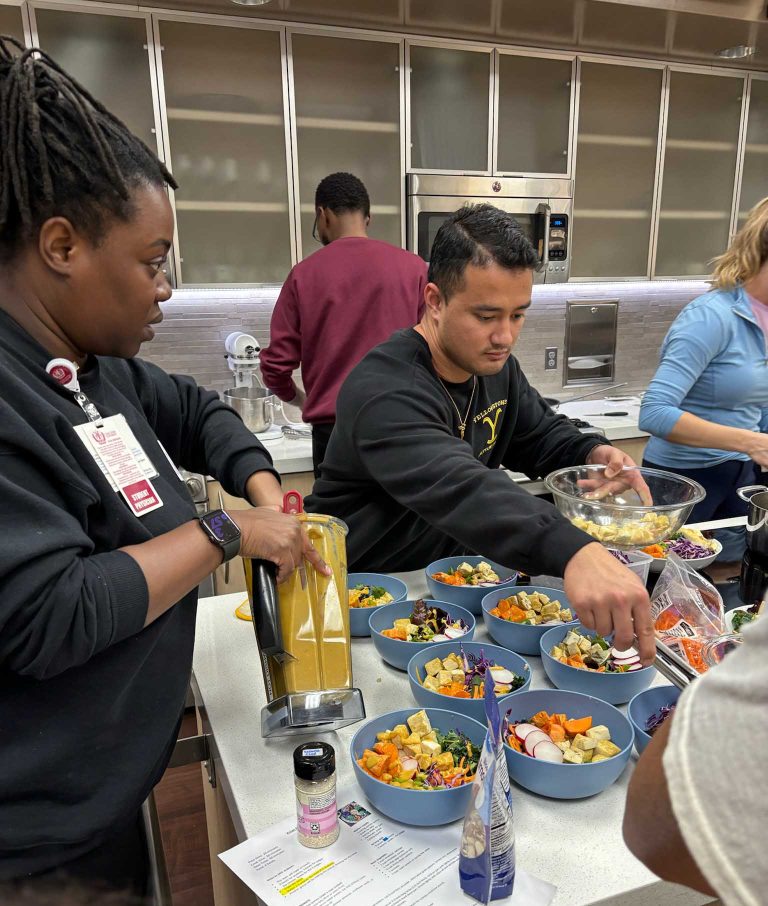
Erwin Stuffle (’27) said culinary medicine “was a tantalizing experience.” He and his group made whole food plant-based and DASH-compliant chili. At first, it was surprising to start by frying onions without oil, but he said the herbs and spices brought out the flavor on their own. Cashew cream and cornbread made by other groups paired to create a remarkable meal. “Honestly it was so good in the end,” Stuffle said.
Cramer is the co-thread director for lifestyle and preventive medicine with Kelsey L. Cherepuschak ’15, MPH. In addition, Cramer oversees culinary medicine for the medical students. Cramer shared that the students enjoy the hands-on learning. “The culinary sessions provide a framework for talking to patients about nutrition prescriptions from first-hand knowledge,” Cramer said.
Stuffle appreciates that lifestyle medicine lectures emphasize that, “Physicians who make healthy choices themselves are more likely to recommend and be able to help their patients. If I’m asking patients to cook without sugar, salt, and oil, I have to know what that’s like. That’s something I’ve definitely taken with me.”
In the early 2010s, faculty leaders at LLUSM along with their colleagues at ACLM, noted a gap in the literature. “There were published articles about attending physician-level competencies for lifestyle medicine, but we didn’t have similar guidance at the student level. So an ACLM team, including faculty from Loma Linda University along with colleagues from the University of South Carolina, Harvard University, and others, together mapped out the learning goals, objectives, and competencies,” Wilson said.
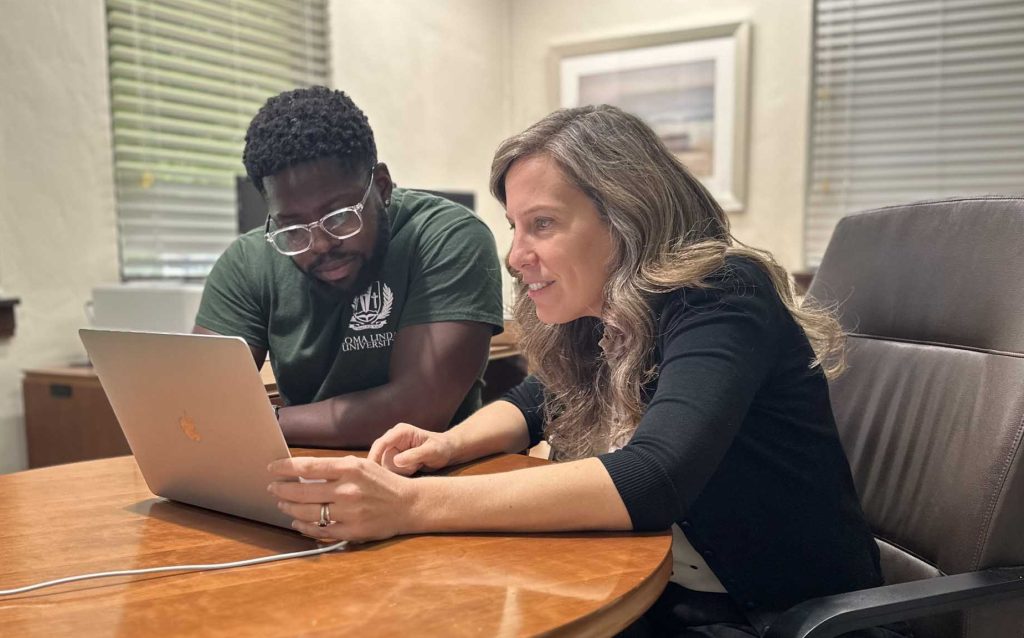
"Physicians who make healthy choices themselves are more likely to recommend and be able to help their patients.”
Erwin Stuffle (’27) Tweet
These efforts were then translated into a white paper published in 2021.5 Wilson cites the publication of this article as a highlight of her career. The certification tiers were built from the foundation of these objectives, and LLUSM intentionally provided support to design the new 2020 Discovery Curriculum with these components in mind.
In acknowledgment of the lifestyle medicine education that all medical students at LLUSM receive, students are awarded an official ACLM certificate. In addition, 12–16 students per year are accepted into a competitive Lifestyle Medicine Certificate Track for additional higher-level educational competency. Track requirements include a capstone research project, quarterly track meetings, workshops, projects, and elective rotations. The class of 2024, the first class to complete all four years in the updated curriculum, had 10 graduates who completed all the additional requirements and were honored at a certificate track banquet recognizing their achievements.
Class of 2024: First Students Complete the Lifestyle Medicine Intensive Track
Sarah Connell, Haley Kempf, Giovanna Nelson, Alexander Hartzell, Brian Hwang, Lance Hofer-Draper, Kristen Proctor, Jedel Butoy, Izuchi Ikegbu, CJ Walters
Learning about the six pillars and having wellness activities worked into his schedule, Stuffle said “was such a rejuvenating and special experience.” He appreciated the plant-based-first approach to modifying health, “instead of relying so heavily on pharmaceuticals. I really appreciate that being built into the curriculum.”
Now that students are learning lifestyle medicine and incorporating it into medical care, LLU faculty and department chairs who are not as familiar with the paradigm are wanting to learn more. “It’s just incredibly rewarding to see all these different pieces coming together where students are both learners, and they are also advocates,” Wilson said.
Tamara L. Thomas ’87, dean of the School of Medicine, said, “As chronic disease continues to increase, we need a greater focus on the underlying factors that create disease in the first place. Our students, residents, fellows, and faculty are already stepping into this gap. Our graduates will take what they have learned and positively impact patients across the U.S. and around the world, helping their patients to live longer, more vibrant lives.”
Endnotes
- Walter C. Willett, “Balancing Life-Style and Genomics Research for Disease Prevention,” Science 296, no. 5568 (April 26, 2002): 695–98, https://doi.org/10.1126/science.1071055.
- Earl S. Ford et al., “Healthy Lifestyle Behaviors and All-cause Mortality Among Adults in the United States,” Preventive Medicine 55, no. 1 (July 1, 2012): 23–27, https://doi.org/10.1016/j.ypmed.2012.04.016.
- Earl Ford et al., “Healthy Living Is the Best Revenge,” Archives of Internal Medicine 169, no. 15 (August 10, 2009): 1355, https://doi.org/10.1001/archinternmed.2009.237.
- https://adventisthealthstudy.org/
- Trilk, J., Worthman, S., Shetty, P., Studer, K., Wilson, A., Wetherill, M., Whelan, L., Bansal, S., Alexander, M., Frates, B., Cramer, S., Rea., B. Undergraduate Medical Education: Lifestyle Medicine Curriculum Implementation Standards. American Journal of Lifestyle Medicine. April 27, 2021 PMID: 34646101.
By EXECUTIVE CHEF VICTOR VARGAS ORTIZ
Three Bean Chili with Tempeh
Portions: 4 | Serving size: 1 cup
Ingredients
- 4 tsp Chili powder
- ½ tsp Cumin, ground
- 1 tsp Oregano, dry
- ½ tsp Paprika
- 1/4 tsp Salt, kosher
- 1 Tbsp Nutritional yeast
- 1 cup Kidney beans, drained
- 1 cup Black beans, drained
- ½ cup Garbanzo beans, drained
- 1/3 cup Tempeh, crumbled
- ½ small Onion, small dice
- ¼ cup Bell pepper, small dice
- ¼ cup Red bell pepper, small dice
- 1 tsp Garlic, minced
- 1 ¼ cup Tomato, diced, low sodium, in juice
- 1 ½ tsp Tomato paste
- 2 cups Veg. stock, low sodium
Method
- Rinse and drain all beans, set aside
- Combine all dry spices, set aside
- Heat large pot until medium hot. Add enough stock to cover bottom then cook onion and peppers until just softening, about 3 minutes
- Add dry spices and garlic. Cook an additional minute while stirring
- Add tomato, with juice, and tomato paste, cook an additional 5 minutes, stirring as needed
- Add stock, beans, and tempeh
- Mix well and bring to a simmer
- Cook 25-30 minutes stirring occasionally
- Serve hot with cashew sour cream and chopped green onions
Cashew Sour Cream
Portions: 8 | Serving size: 2 TB
Ingredients
- 1/2 cup Cashews, pieces, raw
- 1 TBSP Lemon juice, fresh
- 1/2 tsp Vinegar, distilled
- 5 fl oz Soy milk
- 2 tsp Nutritional yeast
- 1/8 tsp Salt (pinch)
Method
- Place cashews in a sealable container, cover with water, and refrigerate overnight
- Drain soaked cashews
- Transfer to a powerful blender and add remaining ingredients. Blend on highest speed until well blended and creamy, scraping sides of container as needed with a rubber spatula to ensure all nuts get blended
- Taste and adjust seasoning with additional lemon juice as needed. Adjust consistency with additional water to achieve a slack but spoonable consistency
- Refrigerate until ready to use
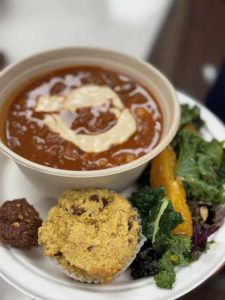
Published in the Summer 2024 ALUMNI JOURNAL.
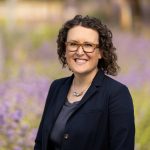 Danelle Taylor Johnston, MA, is fascinated with the human voyage, documenting stories through writing and photography. She loves spending time in nature and making craft chocolate.
Danelle Taylor Johnston, MA, is fascinated with the human voyage, documenting stories through writing and photography. She loves spending time in nature and making craft chocolate.

